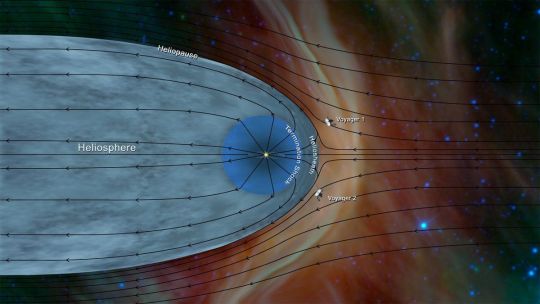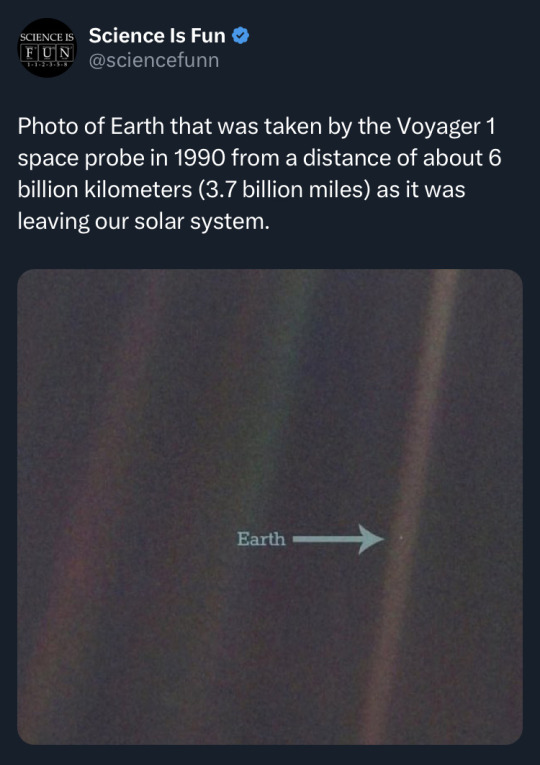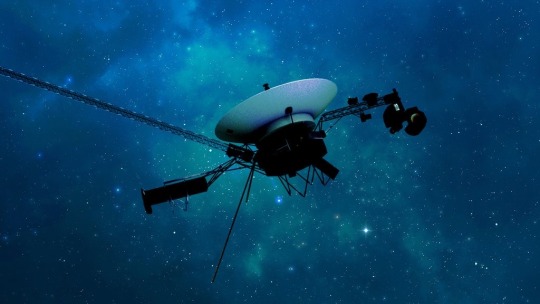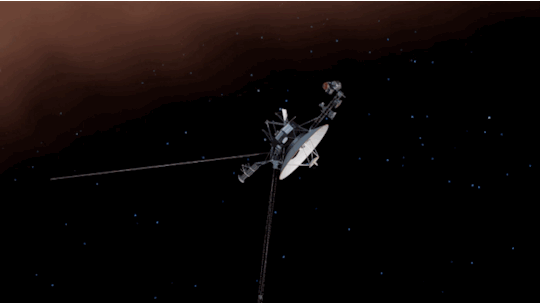#interstellar voyager missions
Text
I've been thinking about the Voyager golden records and all of the things Humanity thought important to include on our first and only true message to the stars and how it included greetings like "have you eaten yet?" And rock n roll music and a child laughing and a woman meditating on being in love. How it included the needle point and printed diagram on how to play it, how it used the time signature of the change of a hydrogen atom and then information about that atom, how we decided that would be the mark of an intelligent race. Those records are not on target to hit anything for a sextillian (one thousand million million million, 10^21, 1 000 000 000 000 000 000 000) years. How it included videos of people eating and pictures of Isaac Newton's work and Bach and truly, truly what we believe to be the best parts of humanity and it will outlast us!! It will outlast our planet, our sun, our whole galaxy- this message in a bottle cast to a truly infinite sea, with a higher chance of never being found even IF intelligent life is out there, these two records containing all of the hope and desperation of humanity to say we existed!! We are no more but we did live and love and these are the very best pieces of us! Look, our reproduction system! Listen to this song! Watch this woman stand in a store and smile! The human diagrams are waving to a people they will likely never meet in the infinite painful hope that someone will find them and see us and remember us and-

#interstellar voyager missions#voyager golden record#space#just holy fuck dude!!! holy shit and fuck!!#and you know what the record says on it? do you know?#to the makers of music- all worlds all times#humans are SO#it has photographs of our planet... and if its ever found this planet wont even exist anymore and isnt that love?? isnt it?? arent we so#my heart is both full and breaking and I simply-#*muffled screaming*
26 notes
·
View notes
Link
The Space, Astronomy & Science Podcast.
SpaceTime Series 27 Episode 34
*SpaceX's Starship Tests the Limits of Spaceflight
In a breathtaking display of rocketry, SpaceX's Starship edges closer to the stars, nearly perfecting its third flight test. The behemoth of engineering, the Starship Super Heavy, roared through the Texan skies, reaching for orbital velocity. Despite a few hiccups, including the loss of both the Starship and its Super Heavy booster, the test marked significant progress towards SpaceX's ambitious goals for space colonization.
*Voyager 1: The Silent Pioneer's Uncertain Future
Voyager 1, humanity's farthest-flung emissary, is now sending back puzzling signals from interstellar space. After over four decades of travel, the spacecraft's communication has become erratic, leaving scientists at NASA's Jet Propulsion Laboratory scrambling to decode the mystery. Could this be the twilight of the mission that has reshaped our understanding of the solar system?
*A New Window into the High-Energy Cosmos
The EROSITA telescope, despite geopolitical tensions, has beamed back a treasure trove of X-ray data, revealing the energetic intricacies of the universe like never before. Australian scientists leverage this data to unveil the violent dance of a star shredded by a black hole and the haunting remnants of a supernova. These cosmic cataclysms, observed in unprecedented detail, offer clues to the violent processes shaping galaxies and the fate of stars.
*Rocket Lab's Back-to-Back Launch Success
Hot on the heels of a groundbreaking space debris removal satellite launch, Rocket Lab continues its winning streak with the 45th Electron rocket launch. The mission expands an Earth observation constellation, proving the company's rapid launch capabilities. With eyes now set on their first launch from American soil, Rocket Lab is poised to make space access even more routine.
For more SpaceTime and to support the show, visit our website at https://spacetimewithstuartgary.com where you can access our universal listen link, find show notes, and learn how to become a patron.
Listen to SpaceTime on your favorite podcast app with our universal listen link: https://spacetimewithstuartgary.com/listen and access show links via https://linktr.ee/biteszHQ
Support the show: https://www.spreaker.com/podcast/spacetime-with-stuart-gary--2458531/support
For more space and astronomy podcasts, visit our HQ at https://bitesz.com
(00:00) SpaceX's Starship aces most of its third test flight
(07:40) Voyager 1's mission may be nearing its end
(13:58) Astronomers get a clearer picture of the high-energy X-ray sky
(19:49) Rocket Lab successfully launches 45th Electron rocket
(23:04) The science report: The link between outer suburban living and childhood asthma
(26:53) Hydroxychloroquine linked to nearly 17,000 deaths during the pandemic
#energy#engines#flight#high#hot#interstellar#mission#one#orbital#raptor#separation#space#spacex#stage#starship#test#third#universe#velocity#voyager
0 notes
Text
Voyager: Humanity's Cosmic Journey
In the vast expanse of the universe, two unassuming spacecraft have embarked on an extraordinary odyssey that has captured the imagination of humanity for decades. Launched by NASA in the late 1970s, Voyager 1 and Voyager 2 have become iconic symbols of human curiosity and exploration. These twin probes have not only provided us with invaluable data about the outer planets of our solar system but…

View On WordPress
#cosmic journey#extraterrestrial civilizations#Golden Record#human curiosity#interstellar space#NASA#outer planets#planetary exploration#space exploration#Voyager#Voyager mission#Voyager spacecraft
0 notes
Text
The Voyager 2 spacecraft was almost lost by NASA permanently.
In a remarkable turn of events on July 21, Suzanne Dodd’s team undertook a routine command transmission to Voyager 2, but an inadvertent error led to a minor misalignment of the probe’s antenna away from Earth. Consequently, the anticipated data exchange failed, raising concerns about the connection with Voyager 2, stationed more than 12.4 billion miles away. This incident posed a potential…

View On WordPress
#communication restoration#deep space exploration#heliosphere#human error#interstellar medium#interstellar spacecraft#Jet Propulsion Laboratory#mission success#NASA#radioisotope thermoelectric generators#scientific instruments#space missions.#space science#spacecraft aging#Voyager 2
1 note
·
View note
Text
NASA Restore the permanent contact with Voyager 2 spacecraft know how
हाइलाइट्स
21 जुलाई को नासा का वॉयजर 2 से संपर्क स्थायी तौर पर कट गया था.
इसकी वजह से गलती से एक आदेश का जाना था जिससे यान का एंटीना मुड़ गया था.
अब शक्तिशाली ट्रांसमीटर से एंटीना सुधारने के आदेश पहुंचने से यह सफलता मिल सकी.
कुछ हफ्तों पहले ही अमेरिकी स्पेस एजेंसी नासा का अपने एक प्रतिष्ठित यान वॉयजर 2 से संपर्क टूट गया था. इसके बारे में बताया जा रहा था कि वैसे तो कई तरह से वॉयजर 2 से संपर्क करने…

View On WordPress
#contact#Deep Space Network#Interstellar Space#JPL#nasa#permanent#Research#Restore#science#Solar System#Space#spacecraft#Voyager#Voyager 2#Voyager mission
0 notes
Text
NASA's Voyager 2 spacecraft is alone drifting through interstellar space after a communications breakdown left it unable to receive commands or transmit data back to Earth.
Communications with Voyager 2, which is currently around 12.4 billion miles (19.9 billion kilometers) from Earth, were severed as a result of planned commands. These commands rotated the spacecraft's antenna two degrees away from our planet, enough to cut its links to the ground antennas of NASA's Deep Space Network (DSN).
As a result, Voyager 2 is no longer sending data back to the DSN, and mission control on Earth can't send any commands back to the interstellar spacecraft.
Not all is lost, however. Voyager 2, launched in 1977, is programmed to reset its orientation several times a year to keep its antenna directed at Earth. Another reset is scheduled for Oct. 15 this year, and this should result in Voyager 2 resuming contact with its ground control. Until that time, operators expect the spacecraft to stick to its planned trajectory.

Voyager 2 was launched from Launch Complex 41 at Cape Canaveral, Florida, on August 20, 1977. It made history on Dec. 10, 2018, when it became the second spacecraft to leave the solar system and enter interstellar space.
Six years prior to this, its sister craft Voyager 1 became the first man-made craft to journey beyond the influence of our star, the sun. Voyager 1 is currently around 15 billion miles (24 billion km) from Earth and remains in contact with our planet.
Both Voyager 1 and 2 were designed to find and study objects at the edge of the solar system, according to NASA. In the course of doing this, Voyager 2 has been responsible for a number of scientific firsts. It is the only spacecraft that has conducted close-up studies of all four giant planets of the solar system — the gas giants Jupiter and Saturn and the ice giants Neptune and Uranus.
In Jan. 1986, Voyager 2 became the first human-made object to fly past Uranus. During that trip, Voyager 2 discovered 10 new moons and two new rings around the ice giant. In Aug. 1989, it also became the first spacecraft to buzz past Neptune, and while there, it discovered five moons and four rings. While studying Neptune, Voyager 2 also discovered an 8,100-mile by 4,100-mile (13,036 km by 6,600 km) cyclonic storm with winds of up to 1,300 miles per hour (2,092 km/h) raging on the ice giant, which has been dubbed the Great Dark Spot.
In April 2023, NASA announced that Voyager 2 would postpone a planned instrument shutdown by at least three years, continuing to gather valuable deep space data until at least 2026.
"We are definitely interested in keeping as many science instruments operating as long as possible," Voyager project scientist at NASA's Jet Propulsion Laboratory in southern California, Linda Spilker, said in a statement issued on Wednesday, April 26.
1K notes
·
View notes
Text
Updated:
The agency’s Deep Space Network facility in Canberra, Australia, sent the equivalent of an interstellar “shout” more than 12.5 billion miles (19.9 billion kilometers) to Voyager 2, instructing the spacecraft to reorient itself and turn its antenna back to Earth. With a one-way light time of 18.5 hours for the command to reach Voyager, it took 37 hours for mission controllers to learn whether the command worked. At 12:29 a.m. EDT on Aug. 4, the spacecraft began returning science and telemetry data, indicating it is operating normally and that it remains on its expected trajectory.
386 notes
·
View notes
Text

Voyager 1 was launched Sept. 5, 1977, just days after its twin — Voyager 2 — on Aug. 20. Because it was on a faster route to the mission's first encounter, at Jupiter, Voyager 1 overtook Voyager 2 on Dec. 15, 1977. (This was the reason for the order of their naming.)
Voyager 1 flew past Jupiter on March 5, 1979, and Saturn on Nov. 12, 1980.
After snapping the Pale Blue Dot and other “family photos,” — at 05:22 GMT, Feb. 14, 1990 — Voyager 1 powered off its cameras forever. Mission planners wanted to save its energy for the long journey ahead.
In August 2012, Voyager 1 entered interstellar space. It’s now the most distant human-made object ever.
If you enjoyed this post, please give it a ❤️ and check out @scienceisdope for more science and daily facts.
481 notes
·
View notes
Text
"well youve had it 6 years that's a good amount of time for that kind of thing to work"
"you should be grateful you got 3 years of use out of that thing, I'm lucky if mine last a year haha"
listen, in 1977 nasa launched the voyager spacecrafts to take advantage of a planetary alignment that takes place every 175 years. These 2 crafts were planned to flyby the outer planets of our solar system and gather data on them to send back to us. Voyager 2 launched first on the 20th of August despite its name because it was planned to reach our gas giants after its counterpart voyager 1, which launched a little later on the 5th of September.
The voyager mission was planned to end 12 years later in 1989. In that time, voyager 1 and 2 passed by Jupiter, Saturn, Uranus, and Neptune. They discovered new moons, confirmed theories about Saturn's rings, found the first active volcanoes found outside the earth, and they take close-up images of planets only seen at that point from telescopes.
On the 25th of August 1989, voyager 2 encounters Neptune, the last planet in our solar system the voyagers will meet. And that was that. End of mission. Now obsolete.
~
Less than 1 year later on valentine's day in 1990 voyager 1 looked back on the planet that had built it and sent with it a world's worth of hopes and dreams and took a picture. We called it the solar system family portrait and in it, we see ourselves. The pale blue dot nestled in the darkness of space
And then commands were sent to shut down their cameras. Preserve fuel.
35 years after launch, in 2012 voyager 1 sent back to us data about interstellar space. The very first manmade object to enter it.
41 years after launch voyager 2 did the same. Still operational, still going. Still sending back to us invaluable data, teaching us about our own solar system and the suns influence in our local bubble of space.
They are expected to continue to operate until the year 2025 - almost 50 whole years after they were launched and 36 years after their mission was supposed to have ended.
48 years of harsh space travel, battered by solar winds, pulled by gravity but fast enough just to escape, pelted by who knows how much space dust and radiation.
And even after that, they still have a purpose. Each craft was given a golden record. A disc filled with human knowledge and knowledge of humans and the planet they live on. Greetings and well-wishes to any prospective extraterrestrial life that could potentially pick it up. Co-ordinates, an invite. Samples of our music, the things we love, sounds of the earth, a story of our world. The surf, the wind, birds and whales, images of a mother, our moon, a sunset. Long after the voyager spacecrafts go dark, probably long after we are gone, they will still be doing their job; educating a species about our very tiny corner of the galaxy.
They are nasa's longest-running operation.
And it was all done using 70s technology.
So excuse me if I want a phone that lasts more than 2 years or a vacuum cleaner that doesn't break down after 6, or god fucking forbid, a refrigerator that will keep my food cold my entire fucking lifetime.
#voyager space#voyager#voyager 1#voyager 2#nasa#planned obsolescence#capitalism#im sorry i took the opportunity to talk a little about the voyagers#they make me emotional okay#i just want things to last without breaking and then being sent to landfill#they did it in the fucking 70s#capitalism is not tenable and i cant afford to keep replacing the gadgets that broke for no other reason than they were built with shit
221 notes
·
View notes
Text



𝐓𝐇𝐄 𝐂𝐎𝐒𝐌𝐎𝐒 𝐁𝐔𝐑𝐍𝐒 𝐀𝐍𝐃 𝐘𝐄𝐓 𝐖𝐄 𝐄𝐍𝐃𝐔𝐑𝐄
In the 25th century, Earth is a distant memory, a lost relic of the past. Humanity has mastered the art of space exploration, weaving through galaxies with the grace of seasoned travelers. Among these cosmic voyagers is the ship Apeiron, a vessel carrying the last precious plant specimens from Earth, a fragile hope for cultivating new life on untamed worlds. When an urgent distress signal echoes through the void, a special force is assembled, driven by a mission of profound importance: to retrieve Apeiron and its invaluable cargo, a beacon of life for a new homeland.
Yet, beneath the surface of duty lies an amalgamation of personal stakes and hidden motives. Each member of the rescue crew is drawn by more than the promise of salvation. They seek answers, redemption, and the unraveling of mysteries shrouded in the silence of the drifting spaceship. In the vast expanse of space, where stars whisper secrets and shadows hold the past, their journey intertwines destiny with the echoes of lost worlds.
EXODUS is a 21+ literate sci fi roleplay inspired by the three body problem, interstellar, 1899 and love death and robots. Join a small crew of 13 people aboard the Exodus to uncover the mysteries left behind on the Apeiron. This game will include interactive mechanics and be played on discord.
[ ∅ REBLOG FOR EARLY GAME DOC ACCESS ∅]
49 notes
·
View notes
Text
Debugging Code 15 Billion Miles Away
NASA’s Voyager 1 Resumes Sending Engineering Updates to Earth

For the first time since November, NASA’s Voyager 1 spacecraft is returning usable data about the health and status of its onboard engineering systems. The next step is to enable the spacecraft to begin returning science data again. The probe and its twin, Voyager 2, are the only spacecraft to ever fly in interstellar space (the space between stars).

Voyager 1 stopped sending readable science and engineering data back to Earth on Nov. 14, 2023, even though mission controllers could tell the spacecraft was still receiving their commands and otherwise operating normally. In March, the Voyager engineering team at NASA’s Jet Propulsion Laboratory in Southern California confirmed that the issue was tied to one of the spacecraft’s three onboard computers, called the flight data subsystem (FDS). The FDS is responsible for packaging the science and engineering data before it’s sent to Earth.
The team discovered that a single chip responsible for storing a portion of the FDS memory — including some of the FDS computer’s software code — isn’t working. The loss of that code rendered the science and engineering data unusable. Unable to repair the chip, the team decided to place the affected code elsewhere in the FDS memory. But no single location is large enough to hold the section of code in its entirety.
So they devised a plan to divide the affected code into sections and store those sections in different places in the FDS. To make this plan work, they also needed to adjust those code sections to ensure, for example, that they all still function as a whole. Any references to the location of that code in other parts of the FDS memory needed to be updated as well.
The team started by singling out the code responsible for packaging the spacecraft’s engineering data. They sent it to its new location in the FDS memory on April 18. A radio signal takes about 22 ½ hours to reach Voyager 1, which is over 15 billion miles (24 billion kilometers) from Earth, and another 22 ½ hours for a signal to come back to Earth. When the mission flight team heard back from the spacecraft on April 20, they saw that the modification worked: For the first time in five months, they have been able to check the health and status of the spacecraft.
35 notes
·
View notes
Text

NASA’s Voyager 1 Resumes Sending Engineering Updates to Earth
After some inventive sleuthing, the mission team can — for the first time in five months — check the health and status of the most distant human-made object in existence.
For the first time since November, NASA’s Voyager 1 spacecraft is returning usable data about the health and status of its onboard engineering systems. The next step is to enable the spacecraft to begin returning science data again. The probe and its twin, Voyager 2, are the only spacecraft to ever fly in interstellar space (the space between stars).
Voyager 1 stopped sending readable science and engineering data back to Earth on Nov. 14, 2023, even though mission controllers could tell the spacecraft was still receiving their commands and otherwise operating normally. In March, the Voyager engineering team at NASA’s Jet Propulsion Laboratory in Southern California confirmed that the issue was tied to one of the spacecraft’s three onboard computers, called the flight data subsystem (FDS). The FDS is responsible for packaging the science and engineering data before it’s sent to Earth.
The team discovered that a single chip responsible for storing a portion of the FDS memory — including some of the FDS computer’s software code — isn’t working. The loss of that code rendered the science and engineering data unusable. Unable to repair the chip, the team decided to place the affected code elsewhere in the FDS memory. But no single location is large enough to hold the section of code in its entirety.
So they devised a plan to divide the affected code into sections and store those sections in different places in the FDS. To make this plan work, they also needed to adjust those code sections to ensure, for example, that they all still function as a whole. Any references to the location of that code in other parts of the FDS memory needed to be updated as well.
The team started by singling out the code responsible for packaging the spacecraft’s engineering data. They sent it to its new location in the FDS memory on April 18. A radio signal takes about 22 ½ hours to reach Voyager 1, which is over 15 billion miles (24 billion kilometers) from Earth, and another 22 ½ hours for a signal to come back to Earth. When the mission flight team heard back from the spacecraft on April 20, they saw that the modification worked: For the first time in five months, they have been able to check the health and status of the spacecraft.
During the coming weeks, the team will relocate and adjust the other affected portions of the FDS software. These include the portions that will start returning science data.
Voyager 2 continues to operate normally. Launched over 46 years ago, the twin Voyager spacecraft are the longest-running and most distant spacecraft in history. Before the start of their interstellar exploration, both probes flew by Saturn and Jupiter, and Voyager 2 flew by Uranus and Neptune.
19 notes
·
View notes
Link
The Space News Podcast.
SpaceTime Series 26 Episode 152
*Deciphering the ancient history of a Martian lake NASA’s Mars Perseverance rover has just passed its one thousandth Martian day on the red planet.
*MAVEN watches as the Sun’s solar wind suddenly disappears In December 2022, NASA’s Mars Atmosphere and Volatile EvolutioN – or MAVEN spacecraft observed the dramatic and unexpected “disappearance” of the solar wind.
*Computer issues affecting Voyager 1 in interstellar space NASA Engineers are working to resolve an issue with one of the Voyager 1 spacecraft’s three onboard computers.
*The Science Report
The new inhaled COVID-19 vaccine that triggers a better immune response than injectable vaccines. Scientists have created the world’s first supermirrors in the mid-infrared range.
New study warns that more than four hours of smartphone use daily was linked to an increased health risk.
Alex on Tech The Deep South super computer
Listen to SpaceTime on your favorite podcast app with our universal listen link: https://spacetimewithstuartgary.com/listen and access show links via https://linktr.ee/biteszHQ
For more SpaceTime and show links: https://linktr.ee/biteszHQ
For more podcasts visit our HQ at https://bitesz.com
#astronomy #space #science #news #podcast #spacetime
#astronomy#deep-south#interstellar#mars#maven#mission#news#podcast#science#space#spacetime#starstuff#sun#voyager-1
0 notes
Text
For the first time since November, NASA’s Voyager 1 spacecraft is returning usable data about the health and status of its onboard engineering systems. The next step is to enable the spacecraft to begin returning science data again. The probe and its twin, Voyager 2, are the only spacecraft to ever fly in interstellar space (the space between stars).
Voyager 1 stopped sending readable science and engineering data back to Earth on Nov. 14, 2023, even though mission controllers could tell the spacecraft was still receiving their commands and otherwise operating normally.
[...] Launched over 46 years ago, the twin Voyager spacecraft are the longest-running and most distant spacecraft in history. Before the start of their interstellar exploration, both probes flew by Saturn and Jupiter, and Voyager 2 flew by Uranus and Neptune.
8 notes
·
View notes
Text
I'll never get tired of this story. This is the NASA that got Apollo 13 home safe.
6 notes
·
View notes
Text
For the first time since November, NASA’s Voyager 1 spacecraft is returning usable data about the health and status of its onboard engineering systems. The next step is to enable the spacecraft to begin returning science data again. The probe and its twin, Voyager 2, are the only spacecraft to ever fly in interstellar space (the space between stars).
Voyager 1 stopped sending readable science and engineering data back to Earth on Nov. 14, 2023, even though mission controllers could tell the spacecraft was still receiving their commands and otherwise operating normally. In March, the Voyager engineering team at NASA’s Jet Propulsion Laboratory in Southern California confirmed that the issue was tied to one of the spacecraft’s three onboard computers, called the flight data subsystem (FDS). The FDS is responsible for packaging the science and engineering data before it’s sent to Earth.
The team discovered that a single chip responsible for storing a portion of the FDS memory — including some of the FDS computer’s software code — isn’t working. The loss of that code rendered the science and engineering data unusable. Unable to repair the chip, the team decided to place the affected code elsewhere in the FDS memory. But no single location is large enough to hold the section of code in its entirety.
So they devised a plan to divide the affected code into sections and store those sections in different places in the FDS. To make this plan work, they also needed to adjust those code sections to ensure, for example, that they all still function as a whole. Any references to the location of that code in other parts of the FDS memory needed to be updated as well.
2 notes
·
View notes